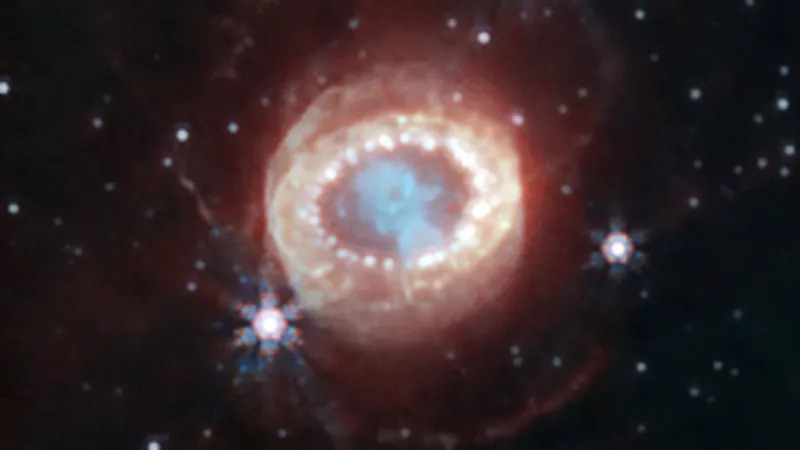
A Nearby Supernova: Could This Be the Key to Unveiling Dark Matter?
2024-11-24
Author: Rajesh
A Nearby Supernova: Could This Be the Key to Unveiling Dark Matter?
For nearly a century, the enigmatic concept of Dark Matter has stumped astronomers and cosmologists alike. This invisible substance, first theorized in the 1960s to explain the rotational dynamics of galaxies, comprises a staggering 85% of the Universe's total mass and interacts only with normal matter through the force of gravity. Central to our most accepted cosmological model, the Lambda Cold Dark Matter (LCDM) framework, Dark Matter remains one of the greatest mysteries in contemporary astrophysics. However, recent groundbreaking research suggests that a nearby supernova might hold the answers we've been searching for.
Among the potential candidates for Dark Matter, the axion—a hypothetical particle proposed in the 1970s—has gained significant attention. These low-mass particles are thought to play a crucial role in resolving several gaps in quantum theory. A recent study led by astrophysicists from the University of California, Berkeley, posits that gamma rays emitted during a supernova could lead to the discovery of axions within mere seconds of the explosion. This study, supported by the U.S. Department of Energy, was featured in the prestigious journal *Physical Review Letters* and represents a significant leap in our understanding of Dark Matter.
Researchers from the Berkeley Center for Theoretical Physics (BCTP) suggest that massive stars going supernova—specifically during the first 10 seconds of their core collapse to form neutron stars—will produce axions in large quantities. These axions can then convert into detectable high-energy gamma rays through the intense magnetic fields surrounding the dying star.
Historically, the quest for Dark Matter has led scientists down various paths, from exploring Massive Compact Halo Objects (MACHOs) to Weakly Interacting Massive Particles (WIMPs). However, with these pursuits yielding no conclusive findings, the search has pivoted to axions, which fit seamlessly within the Standard Model of Particle Physics and promise solutions to longstanding quantum mechanical challenges.
The prime candidate for axions is the quantum chromodynamics (QCD) axion, an entity theorized to interact weakly with all forms of matter. While previous studies indicate that these particles could transform into photons in the presence of strong magnetic fields, detecting them remains an uphill battle since it requires a supernova to be relatively close—ideally within our own Milky Way galaxy or its nearby companions.
The last observed supernova, SN1987A, erupted in the Large Magellanic Cloud approximately 168,000 light-years from Earth. Back in 1987, NASA's Solar Maximum Mission was observing the explosion but wasn't sensitive enough to capture the anticipated gamma ray intensity. Benjamin Safdi, a UC Berkeley physics associate professor and lead author of the study, noted that a modern gamma-ray telescope would dramatically enhance our detection capabilities.
"If we were to see a supernova like 1987A with today’s technology, we could confirm or rule out the existence of the QCD axion across a vast range of its theoretical mass—much of what cannot be tested in laboratory environments," Safdi explained.
Utilizing advanced supercomputer simulations based on SN1987A, researchers demonstrated how Type II supernovae emit simultaneous bursts of gamma rays and neutrinos. Remarkably, the gamma rays produced depend heavily on the axion's mass, lasting only 10 seconds after the neutron star forms. To maximize the chances of capturing these photons, gamma-ray telescopes need to be precisely aligned with the supernova at just the right moment.
Currently, the Fermi Gamma-ray Space Telescope is the only observatory capable of such observations. However, it has only a one-in-ten chance of detecting a supernova event due to its limited field of view. This possibility has led the team to propose an advanced gamma-ray telescope dubbed the GALactic AXion Instrument for Supernova (GALAXIS).
"Neutron stars are optimal targets for searching for axions—a fact that opens new avenues in our quest,” Safdi emphasized. “These stellar remnants not only possess extreme temperatures but also contain some of the strongest magnetic fields known in the universe, converting axions into detectable signals."
The implications of successfully detecting gamma rays could be profound. If confirmed, the mass of the axion would be established across many theoretical ranges, enabling laboratory experiments to tailor their focus on verifying these findings. Conversely, even a failure to find gamma rays would help scientists narrow down the range of axion mass possibilities, further refining the search for Dark Matter.
As the scientific community holds its breath, the hope is that the Fermi telescope might stumble upon a supernova during its operational lifetime. "In the best-case scenario, Fermi captures a supernova event," Safdi added. "The chances may be slim, but should it happen, we could piece together the mass and interaction strength of the elusive axion, thus gaining a clearer picture of this cosmic riddle."
Stay tuned—astronomy might be on the brink of solving one of its greatest mysteries, all thanks to a star going supernova. Will this event finally unlock the secrets of Dark Matter? Only time will tell.



 Brasil (PT)
Brasil (PT)
 Canada (EN)
Canada (EN)
 Chile (ES)
Chile (ES)
 España (ES)
España (ES)
 France (FR)
France (FR)
 Hong Kong (EN)
Hong Kong (EN)
 Italia (IT)
Italia (IT)
 日本 (JA)
日本 (JA)
 Magyarország (HU)
Magyarország (HU)
 Norge (NO)
Norge (NO)
 Polska (PL)
Polska (PL)
 Schweiz (DE)
Schweiz (DE)
 Singapore (EN)
Singapore (EN)
 Sverige (SV)
Sverige (SV)
 Suomi (FI)
Suomi (FI)
 Türkiye (TR)
Türkiye (TR)